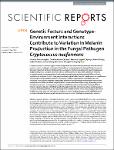Environment Interactions Contribute to Variation in Melanin Production in the Fungal Pathogen Cryptococcus neoformans
Samarasinghe, Himeshi
Aceituno-Caicedo, David
Cogliati, Massimo
Kwon-Chung, Kyung J.
Rickerts, Volker
Velegraki, Aristea
Ackaglar, Sevim
Xu, Jianping
Cryptococcosis is a common opportunistic fungal infection that often disseminates into the central nervous system, leading to meningitis. Production of melanin pigments during infections is one of the most important virulence factors of its causal agent, the human pathogenic yeast Cryptococcus neoformans species complex. However, almost nothing is known about the patterns of variation in melanin production among clinical and environmental strains and the potential effects of such variations on virulence. In this study, we assembled a global collection of C. neoformans var. neoformans strains and investigated their patterns of melanin variation and potential contributors to such variations. Our analyses revealed that genetic differences and genotype-environment interactions explained up to 59% and 43% of the population’s melanin variance respectively, depending on the tested environments. In comparison, environmental factors alone contributed relatively little to melanin variance. We also identified specific changes within the LAC1 gene, whose protein product catalyzes melanin synthesis, to be associated with variable melanin levels. This study provides fresh insights into the origin and evolution of virulence traits in fungal pathogens while highlighting the complex interplay between genetic and environmental factors that lead to phenotypic variance.
Files in this item

